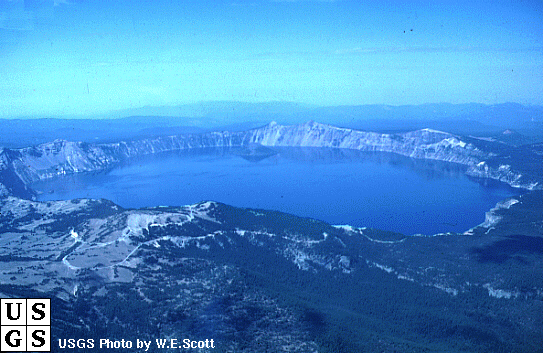
Caldera Eruptions
 |
Typical caldera forming eruptions occur in the late stages of stratovolcano evolution. Apparently the magma gets enriched with volatiles over time, and may give rise to violent eruptions that discharge large volumes of magma from the underlying magma chamber. The emptied chamber is no longer able to carry the weight of the overlying volcano, and and the roof of the chamber (with the volcano) collapses and forms a depression. |
A well known caldera in the US is Crate Lake in Oregon, the remains of a former volcano named Mt. Mazama.

The Mt. Mazama caldera depression is filled with water and forms Crater Lake. At the rim of the lake we see the remains of the outer portion of the former volcano. You can take the slope of these remains and approximately reconstruct the former volcano.
Yellowstone National Park is the site of another huge caldera. The geologic
history of Yellowstone centers around volcanism. The caldera that rings much of the
park was formed by a huge explosion about 600,000 years ago. The magnitude of the eruption
is beyond the realm of imagination: 240 cubic miles of ash were blasted into the
atmosphere, making this eruption perhaps the largest ever to occur on earth. After this
eruption, the magma chamber collapsed into a gigantic pit reaching 28 by 47 miles (45 by
76 kilometers) across, and perhaps several thousand feet deep. Over millennia, the lower
parts of this basin filled with water, forming
Lake Yellowstone.